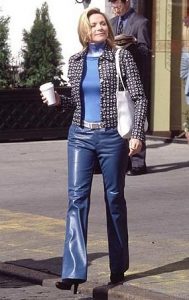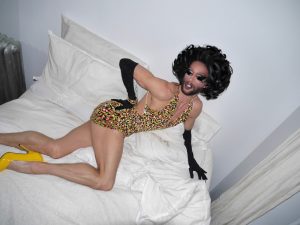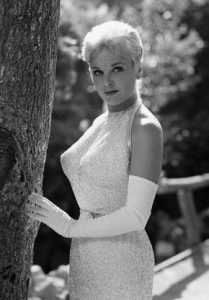Dina’s Diner 11/21/16
WHAT GLAM ROCK LEFT UNSAID
The New York Times Arts section had an interesting essay by Jim Farber about the 1970s phenomenon of Glam Rock titled “Growing Up Glam and Gay” in the November 4, 2016 edition.
Mr. Farber writes about being a closeted gay teen in the mid ’70s when glam rock was in full swing. Speaking of Freddie Mercury’s (of Queen fame) headlining homoeroticism, Farber writes, “Luckily for me, the stupefying naiveté of the ’70s provided cover for even the most flagrant acts of effeminacy.” I remember this feeling myself during those days. Even though the outer trappings of glam rockers and later “hair bands” obviously played into some vein of bisexual eroticism, it was never remotely addressed by the bands and certainly not by their male fans.
Oddly, Farber points out that in the very early days of glam rock, David Bowie and Alice Cooper increased their shock value by professing or hinting at bisexuality. Farber disbelieved the stars and wrote it off as “sissy minstrelsy” to boost their image. But mostly, the androgynous sex appeal — as it relates to male fans, anyway — was always left unexplored. When I bought a used version of Poison’s first album it was strictly for the photo of their makeup and hairdo’s. I never listened to the music. I still have dozens of clippings of hairband magazine photos because I found the makeup, hair, and Spandex outfits tapping into my foggy notions of crossdressing at that time.
But Farber’s larger point in his essay was that whether they realized it or not, these nodding cues to androgyny helped a young gay adult realize he was not alone. He writes, “A movement created by straight people, out to stoke attention by ‘acting gay’ had special meaning for gay youth who felt the need to pass for straight.”
THE TIMELESS APPEAL
Recently, I was sitting at a local bar waiting for a takeout dinner order and drinking a beer. The bar was almost empty and I watched television while drinking and waiting for the food.
A young woman came in and sat several stools from me. She had a scruffy look, her head shaved above her ears, with long, braided strands falling from the top and colored with purple streaks. A short while later she was joined by another female friend.
While waiting, I surveyed the empty bar again. This time I noticed that the young woman was sitting cross-legged on her stool and she was wearing fishnet tights beneath a denim skirt and above black combat-style boots. A typical street urchin punk rock look. But the fishnets definitely had caught my attention and before leaving I stole a few more glances at her be-netted legs.
This chance encounter with unexpected fishnets reminded me of another memorable moment in a hotel lobby nearly thirty years ago. I was standing and surveying the surroundings when I spied an attractive middle-aged woman wearing brown leather dress slacks beneath a cream colored sweater. The slacks were not sexual or fetish-y but merely a touch of upscale fashion captured in a brief, surprising discovery. But still. Leather slacks. Wow. That’s interesting and kind of hot, I thought.
It’s funny how certain inanimate objects can act as triggers for sexual thoughts or crossdressing desires. Fishnets, leather, vinyl, high heels, boots, corsets — you name it. And it seems heightened when the sighting is accidental or unexpected. These triggers have a powerful aura that are hard to ignore when encountered. I can flick right past the late night cable porn movies but if I see a film with an actress in lingerie, a tight dress, or showing cleavage I’ll stick around to at least enjoy that brief scene.
In a modern, enlightened society, maybe I shouldn’t project my sexual thoughts onto a woman wearing fishnets in a bar or a dowager wearing leather slacks in a hotel lobby. It’s wrong to assume that the woman is purposely enticing us with provocative dress because that is happening only in our own heads — not necessarily hers at all. And I do know better. Still, it is fun to look and write our own narrative.
GOOD THINGS COME IN THREES
The New York Times featured ballet dancer James Whiteside in the Arts and Leisure section on October 16, 2016. It was headlined “He Sings! He Pirouettes! He’s in Drag!” Our own TWIT feature mentioned the article on TGForum on October 24, 2016.
Mr. Whiteside is a principal dancer with American Ballet Theater in Manhattan. The Times article covered his three artistic personas, one of which is a drag queen he calls Uhu Betch. The others are his professional dance occupation with the third being a DJ and dance mix vocalist he calls JbDubs.
Mr. Whiteside is an out gay man in an art form with exclusively heterosexual story lines in ballet works. As such, James realized at an early age that he would be forever dancing romantic ballets with women rather than men. He developed the drag character with gay friends while dancing with the Boston Ballet. He told The Times, “Drag tells you exactly what is wrong with the world in a really, really creative, glamorous, funny, sexy way.”
The Times had another interesting quote from the article. Speaking about his DJ persona, Mr. Whiteside said, “I find JbDubs to be less “JbDubs” and more “James” as time progresses because I find myself caring less about separating my interests.” Haven’t we all wished we could roll our private crossdressing selves into a cohesive self?
This article pointed out to me (again) how very far we have come in the acknowledgement — if not universal acceptance — of transgenderism, crossdressing and drag. It would have been very unusual not long ago to have a well-known professional — even in the more open-minded arts community — be open about his drag persona as just another means of self-expression. Now, we have 9 year old boys who want to go out as Bob the Drag Queen for Halloween (see TWIT last week). Being different from the majority may never be at all times easy but perhaps someday being known as a crossdresser will be no big whoop. I hope.
BEAUTY IN BLACK AND WHITE
My cable system includes a few networks that cater to television nostalgia. I only recently started to check them out on a regular basis but they are sometimes a pleasant diversion — especially during the recent election season. Ugh. The networks are MeTV, This, and Decades and I had never heard of them before they appeared on the upper registers of the basic cable spectrum. Reruns of Perry Mason, Alfred Hitchcock, Hazel, Green Acres, The Addams Family and Mister Ed seem as good today as they did in my elementary school years.
The reason I enjoy them so much is the time capsule nature of the fashions and hairdo’s of the late ’50s and early ’60s. I like looking at the men’s hair and clothing almost as much as the women from that period. All the different ways to slick back your hair are on display: the simple side part with swoosh, the comb-over, the full pompadour, even the easily spotted toupees of those days. But let’s face it, ladies: I love the women who populated the sleek environs of the jet age.
I wrote before about my admiration for Eva Gabor’s glamorous Lisa Douglas on Green Acres and Carolyn Jones’ portrayal of sexy, slim Morticia Addams. Aside from the regularly appearing female stars, like Perry Mason’s Barbara Hale, Mister Ed’s Connie Hines, or Hazel’s Whitney Blake, the female guest stars on the shows were often young starlets or former studio beauties who just never made it on the big screen. The lacquered hair, the mascaraed eyes, the pointy bosoms in fitted slimline dresses or soft sweaters is a study in what beauty meant when the nation was evolving from Eisenhower to Kennedy. If you Google search for the actresses featured on these shows, you can invariably find old cheesecake photos that were de rigueur for aspiring female stars in those innocent times. Pat Priest, who played Marilyn (the normal) Munster posed in front of the Munster Koach wearing a leopard print swimsuit. Detective Peter Gunn’s girlfriend, actress Lola Albright, posed in a real fishnet (see item above for kink factor) in a beach themed photo shoot.
These and all the ladies just like them on screen and on the streets were the mental stimulation in my formative years that propelled me towards crossdressing. Who knows why? It is a tribute to either the longevity of their appeal or the stubbornness of my fixation that it still works on my psyche after all these years.
TWO SHORT ITEMS FOR THE END
The New York Times had a feature article on November 6, 2016 about Angela Mao, a 66 year old Chinese restaurant owner in Flushing, Queens, New York. But it was about Mrs. Mao’s previous career that brought the Times to her eating place.
Angela Mao was formerly known as “Lady King Fu” in dozens of Chinese martial arts movies of the 1970s. She was a contemporary of Bruce Lee and, as she put it, “When I was a somebody, Jackie Chan was a nobody.” Her fans are legion and it almost never came to pass because the male Hong Kong and Taiwanese producers believed a female star would never appeal to fans. One man, producer Raymond Chow, did believe it though and the rest, as they say, is King Fu history.
Long story short, Angela made many films and stopped abruptly in the early 1980s when she followed her husband to the U.S. and began running Chinese restaurants. She is aware of her cult fame and indulges the fans that still seek her out but shrugs most of it off as a part of her past that she seems to find not all that remarkable. It was a way to provide for her family. A Chinese tradition honored by a non-traditional female role model.
 The U.S Supreme Court is hearing a case that centers on cheerleader uniforms. The New York Times had an article about it in the October 30, 2016 Sports section. At issue in the lawsuit is whether the ornamental designs — the stripes and zig-zag patterns on the uniforms — are protected by copyright.
The U.S Supreme Court is hearing a case that centers on cheerleader uniforms. The New York Times had an article about it in the October 30, 2016 Sports section. At issue in the lawsuit is whether the ornamental designs — the stripes and zig-zag patterns on the uniforms — are protected by copyright.
The plaintiff, Star Athletica, is suing the leader in cheerleading uniforms, Varsity Brands, to break the latter’s defense that graphic designs on the uniforms are protected by copyright law. Star Athletica points out that the law states that such items must be able to “stand alone as pictorial, graphic or sculptural works.”
As The Times points out and everyone is aware, cheerleading uniforms are fairly standardized when it comes to cut, length and other basics. The only distinguishing thing from one team’s uniform to the next are the graphics and visual designs on the clothing. So a copyright on a stripe pattern or some other ornamentation on a basic garment makes it difficult to create a unique cheerleading uniform. Other athletic apparel makers are watching the case closely since the outcome could open the cheerleading market to new entrants that could be freed from copyright restrictions they now chafe under.
And we don’t want to see those sweet cheerleaders chafing or constrained from sis-boom-bah’ing in spanking new uniforms. So let’s hear it for the plaintiffs.
“Hey, hey, Su-preme Court.
Give us new uniforms,
and make them short!”
Category: Transgender Fun & Entertainment, Transgender Opinion









